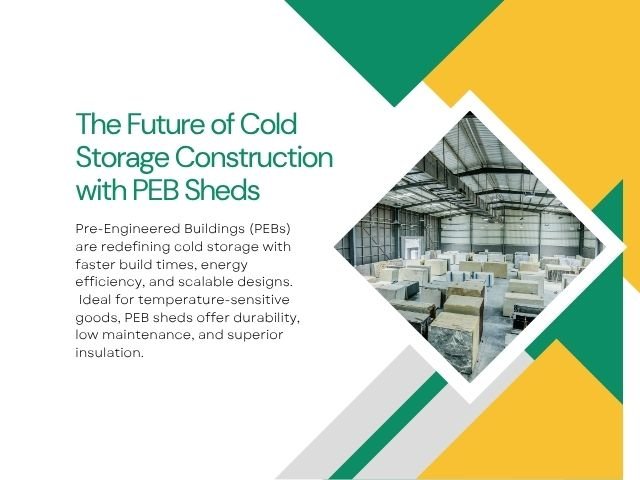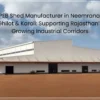The Future of Cold Storage Construction with PEB Sheds
TL;DR: The future of cold storage construction with PEB sheds is transforming the industry by offering faster, cost-effective, and sustainable solutions. Discover how pre-engineered building (PEB) sheds are revolutionizing cold storage with energy efficiency, scalability, and durability.
Introduction: Why Cold Storage Construction Matters More Than Ever
Imagine a world where your groceries spoil before they reach the store or life-saving vaccines lose their potency due to poor storage. Cold storage facilities are the unsung heroes ensuring food, medicine, and other perishables stay fresh. But building these facilities isn’t just about stacking bricks—it’s about precision, efficiency, and sustainability. Enter the future of cold storage construction with PEB sheds, a game-changer that’s redefining how we design and build these critical structures.
With global demand for cold storage skyrocketing—projected to grow by 9% annually through 2030—innovative solutions like pre-engineered building (PEB) sheds are stepping up. These structures offer speed, cost savings, and eco-friendly designs that traditional construction struggles to match. In this article, we’ll explore how PEB sheds are shaping the future of cold storage construction, why they’re a smart choice, and how they align with modern needs for efficiency and sustainability.
What Are PEB Sheds and Why Are They Ideal for Cold Storage?
Pre-engineered building (PEB) sheds are modular structures designed and manufactured off-site, then assembled quickly at the construction site. Unlike traditional buildings, PEB sheds use standardized components, making them faster to build and more cost-effective. For cold storage, they’re a perfect fit due to their flexibility, durability, and ability to integrate advanced insulation systems.
- Speed of Construction: PEB sheds can be erected in weeks, not months, reducing downtime.
- Cost Efficiency: They cut labor and material costs by up to 30% compared to conventional methods.
- Customization: PEBs can be tailored for specific temperature requirements, from frozen to chilled storage.
By leveraging innovative PEB shed designs for cold storage, businesses can meet tight deadlines without compromising quality, making them a cornerstone of modern cold storage solutions.
How PEB Sheds Enhance Energy Efficiency in Cold Storage
Energy costs are a major concern for cold storage facilities, often accounting for 60–70% of operational expenses. PEB sheds address this with advanced insulation and structural designs that minimize energy loss.
- High-Quality Insulation: PEB sheds can integrate insulated panels with high R-values, reducing heat transfer.
- Airtight Construction: Precision engineering ensures minimal air leaks, maintaining consistent temperatures.
- Solar Integration: Many PEB designs support solar panel installation, cutting reliance on grid power.
For example, a cold storage facility in Texas using PEB sheds reported a 25% reduction in energy costs after switching from traditional construction. Energy-efficient cold storage with PEB sheds is not just a trend—it’s a necessity for sustainable operations.
Are PEB Sheds Scalable for Growing Cold Storage Needs?
One of the biggest challenges in cold storage is planning for future growth. As demand for perishable goods rises, facilities must scale without breaking the bank. PEB sheds excel here due to their modular nature.
- Flexible Expansion: Add new sections to an existing PEB shed without major structural changes.
- Quick Modifications: Adjust internal layouts to accommodate new storage requirements.
- Cost-Effective Scaling: Expanding a PEB shed costs significantly less than rebuilding traditional structures.
A fruit distribution company in California used scalable PEB sheds for cold storage expansion to double its capacity in just three months, showcasing the adaptability of this approach.
Why Are PEB Sheds More Sustainable Than Traditional Construction?
Sustainability is no longer optional—it’s a priority. PEB sheds align with sustainable cold storage construction using PEB sheds by reducing waste and environmental impact.
- Recyclable Materials: Most PEB components are made from recyclable steel, reducing landfill waste.
- Efficient Manufacturing: Off-site production minimizes on-site disruption and resource use.
- Lower Carbon Footprint: Faster construction and energy-efficient designs cut emissions.
A 2024 study found that PEB sheds produce 20% less construction waste than traditional methods, making them a greener choice for cold storage projects.
How Do PEB Sheds Ensure Structural Durability?
Cold storage facilities face harsh conditions—extreme temperatures, humidity, and heavy equipment loads. PEB sheds are built to withstand these challenges.
- Robust Materials: High-strength steel ensures long-term durability.
- Corrosion Resistance: Protective coatings prevent rust in humid environments.
- Load-Bearing Capacity: PEB designs support heavy refrigeration units and racking systems.
For instance, a PEB shed cold storage facility in India withstood a monsoon season without structural issues, proving the reliability of durable PEB shed designs for cold storage.
What Role Does Technology Play in PEB Shed Cold Storage?
Technology is reshaping the future of cold storage construction with PEB sheds. From design to operation, advanced tools enhance efficiency and performance.
- BIM Integration: Building Information Modeling (BIM) ensures precise PEB shed designs.
- IoT Monitoring: Sensors track temperature and humidity in real-time, optimizing storage conditions.
- Automation: PEB sheds can house automated racking systems for faster inventory management.
A Midwest cold storage warehouse using IoT-enabled PEB sheds reduced spoilage rates by 15%, highlighting the power of tech-driven solutions.
How Do PEB Sheds Compare to Traditional Cold Storage Construction?
Choosing between PEB sheds and traditional construction depends on cost, speed, and performance. Here’s a quick comparison:
| Feature | PEB Sheds | Traditional Construction |
|---|---|---|
| Construction Time | 4–8 weeks | 6–12 months |
| Cost | 20–30% lower | Higher due to labor and materials |
| Energy Efficiency | High (advanced insulation) | Moderate |
| Scalability | Easily expandable | Costly and time-consuming |
| Sustainability | Recyclable, low waste | Higher waste, less eco-friendly |
This comparison shows why cost-effective cold storage with PEB sheds is gaining traction among businesses.
What Are the Challenges of Using PEB Sheds for Cold Storage?
While PEB sheds offer many benefits, they’re not without challenges. Understanding these helps businesses make informed decisions.
- Initial Design Costs: Customizing PEB sheds for specific needs can be pricey upfront.
- Skilled Labor Needs: Assembly requires trained professionals familiar with PEB systems.
- Aesthetic Limitations: PEB sheds may lack the visual appeal of traditional buildings.
Despite these hurdles, the long-term savings and efficiency of innovative PEB shed designs for cold storage often outweigh the drawbacks.
How Can Businesses Transition to PEB Sheds for Cold Storage?
Switching to PEB sheds requires careful planning. Here’s a step-by-step guide:
- Assess Needs: Determine storage capacity, temperature requirements, and budget.
- Choose a Provider: Partner with a reputable PEB manufacturer with cold storage expertise.
- Design Phase: Use BIM to create a tailored PEB shed design.
- Construction: Leverage the speed of PEB assembly to minimize downtime.
- Monitor Performance: Install IoT systems to track efficiency post-construction.
By following these steps, businesses can embrace scalable PEB sheds for cold storage expansion with confidence.
The Future of Cold Storage Construction with PEB Sheds – Frequently Asked Questions
What are PEB sheds in cold storage construction?
PEB sheds are pre-engineered buildings made from standardized steel components, designed off-site, and assembled quickly. They’re ideal for the future of cold storage construction with PEB sheds due to their speed, cost savings, and energy efficiency.
How do PEB sheds improve energy efficiency in cold storage?
PEB sheds use high-quality insulated panels and airtight designs to reduce energy loss, cutting costs by up to 25%. This aligns with energy-efficient cold storage with PEB sheds.
Are PEB sheds scalable for growing businesses?
Yes, PEB sheds are modular, allowing easy expansion without major structural changes. They’re perfect for scalable PEB sheds for cold storage expansion. Learn more about scalability.
How sustainable are PEB sheds compared to traditional construction?
PEB sheds use recyclable materials and produce less waste, making them a greener choice for sustainable cold storage construction using PEB sheds. See sustainability benefits.
What challenges come with using PEB sheds for cold storage?
Challenges include higher initial design costs and the need for skilled labor. However, durable PEB shed designs for cold storage offer long-term savings. Explore challenges.
Can PEB sheds support advanced technology in cold storage?
Yes, PEB sheds integrate with BIM, IoT, and automation, enhancing efficiency in innovative PEB shed designs for cold storage. Read about technology.
Conclusion: The Cold Storage Revolution Is Here
The future of cold storage construction with PEB sheds is bright, offering a blend of speed, cost savings, and sustainability that traditional methods can’t match. From energy efficiency to scalability, PEB sheds are transforming how businesses store perishables. Whether you’re a small business or a large distributor, scalable PEB sheds for cold storage expansion can meet your needs while keeping costs low. Ready to explore this innovative approach? Share your thoughts or check out our related guides on sustainable construction or energy-efficient designs.






